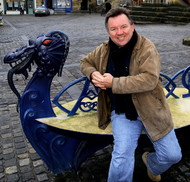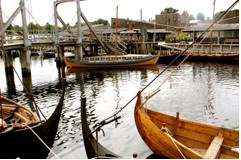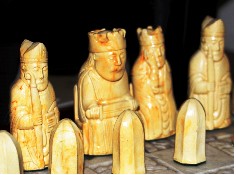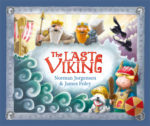Inspirational viking women

Author Norman Jorgensen’s research notes on inspiring Viking women.
Working on The Last Viking and The Last Viking Returns with illustrator James Foley, I was surprised at the amount of research we ended up doing, especially considering the books are kids’ picture books with only the standard 32 pages to cram in the story and the illustrations.
Admittedly, some of the research did involve watching the fabulous History Channel/ SBS program, Vikings. That is the one with the character called Lagertha, played by Katheryn Winnick, who looks a lot like Scarlett Johansson and leads a gang of fierce Shield Maidens. I originally thought the scriptwriters were being a bit loose with their historical accuracy. It wouldn’t be the first time Hollywood has strayed from the truth for dramatic effect, but I could not have been more wrong. I should have realised judging by the authenticity of the rest of the series (there is not a horned helmet in sight).
 Shield Maidens did actually exist, going into battle and replacing fallen warriors at shield walls. Viking girls were given the choice to be taught how to handle swords and fight as warriors, and the Norse sagas often mention female Viking warriors. One of the most famous was Freydis, the sister of Leif Eriksson, who also travelled with him when he (or they) became the first Europeans to discover America.
Shield Maidens did actually exist, going into battle and replacing fallen warriors at shield walls. Viking girls were given the choice to be taught how to handle swords and fight as warriors, and the Norse sagas often mention female Viking warriors. One of the most famous was Freydis, the sister of Leif Eriksson, who also travelled with him when he (or they) became the first Europeans to discover America.
Viking girls who did not fancy a warrior’s glorious but often short life generally staye d home with their longer surviving mothers and grandmothers and learned how to weave cloth and make clothes and also cook and tend animals and sick people, as well as run farms, control slaves, keep the finances and trade.
d home with their longer surviving mothers and grandmothers and learned how to weave cloth and make clothes and also cook and tend animals and sick people, as well as run farms, control slaves, keep the finances and trade.
In Viking society, women were treated much better than those in most other societies in much of history. Unlike English medieval society, and even up until the nineteenth century, where women lost all rights on marriage, all the property a Viking woman brought with her into a Viking marriage continued to be her personal belongings. It was inherited by her children after her death.
With the men away a lot of the time raiding and making nasty nuisances of themselves in other countries, keeping the farm running was hard and vital work, especially during the impossibly harsh winters.
Viking women too had the unique privilege of being able to divorce their husbands by simply standing in front of their Longhouse and declaring, ‘My husband Snorri is a miserable, drunken, wife-beating loser (or something similar) and I divorce him.’ Men had no such rights, and I can’t help wondering if the men behaved themselves better because of this law.
Everyone in an extended family had to share dark, smoky, one-room huts called Longhouses. This included the farm animals to help keep them warm, especially in the long, freezing winters. Unlike today, with their own rooms, girls had no privacy at all.
At age ten, Viking boys, and keen girls, were usually sent away to learn the ways of the warriors and how to fight with swords, spears and battleaxes. Boys were also taught shipbuilding, as all communities owned at least one long, sleek ship called a drakkar. They were also taught how to navigate ships using the stars and coastal landmarks. Some of them also became blacksmiths and toolmakers, and those skilled enough became artisans and made stylish and valuable jewellery.
 The biggest tragedy for Viking children would have been that they didn’t have to go to school. Yeah, right. The printing press wasn’t invented for another 500 years and so there were no books, other than those hand-scribed by the monks in monasteries, and their dads were too busy burning those in raids. Instead, from age five, children spent their time helping to keep the farms running and learning the skills they’d need as adults, usually from their parents. Boy, I bet that was fun. Not.
The biggest tragedy for Viking children would have been that they didn’t have to go to school. Yeah, right. The printing press wasn’t invented for another 500 years and so there were no books, other than those hand-scribed by the monks in monasteries, and their dads were too busy burning those in raids. Instead, from age five, children spent their time helping to keep the farms running and learning the skills they’d need as adults, usually from their parents. Boy, I bet that was fun. Not.
Selected Viking boys even learned how to read and write the Rune characters of the Viking alphabet. Those who could were believed to have magical powers and were well respected in Viking society.
In spite of the long hours children worked, they still found time to play games. Viking archaeological sites have uncovered model drakkars, chess pieces, doll-like figurines, accurate toy wooden swords, wooden animals, musical instruments and bone ice-skates.
 The average age of dying was about half it is these days, mostly due to the harsh conditions Vikings lived with, not to mention all the dangerous battles the Vikings kept picking with their enemies, and their neighbours. Their diet of fermented whale blubber, fermented auk (a puffin-like bird), baked polar bear and a host of other disgusting-sounding food may have contributed as well. Not to mention mead, a honey-based firewater, which Vikings had a reputation for drinking by the Longship-load.
The average age of dying was about half it is these days, mostly due to the harsh conditions Vikings lived with, not to mention all the dangerous battles the Vikings kept picking with their enemies, and their neighbours. Their diet of fermented whale blubber, fermented auk (a puffin-like bird), baked polar bear and a host of other disgusting-sounding food may have contributed as well. Not to mention mead, a honey-based firewater, which Vikings had a reputation for drinking by the Longship-load.




